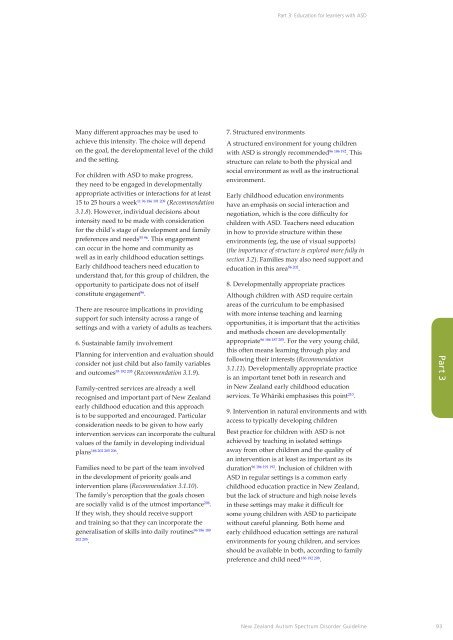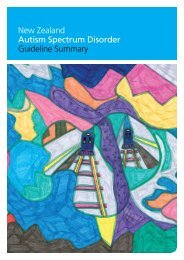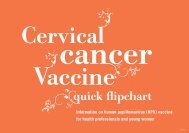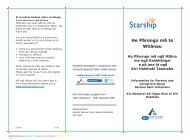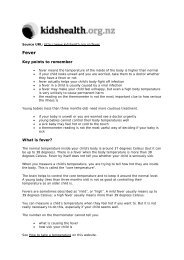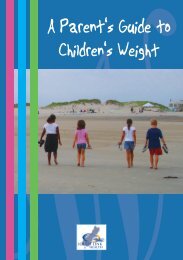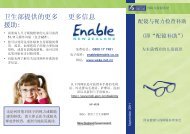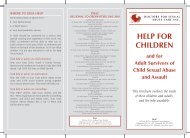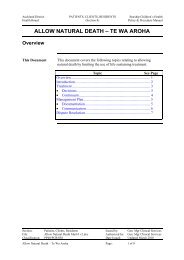New Zealand Autism Spectrum Disorder Guideline - Ministry of Health
New Zealand Autism Spectrum Disorder Guideline - Ministry of Health
New Zealand Autism Spectrum Disorder Guideline - Ministry of Health
Create successful ePaper yourself
Turn your PDF publications into a flip-book with our unique Google optimized e-Paper software.
Part 3: Education for learners with ASD<br />
Many different approaches may be used to<br />
achieve this intensity. The choice will depend<br />
on the goal, the developmental level <strong>of</strong> the child<br />
and the setting.<br />
For children with ASD to make progress,<br />
they need to be engaged in developmentally<br />
appropriate activities or interactions for at least<br />
15 to 25 hours a week 11 96 186 191 209 (Recommendation<br />
3.1.8). However, individual decisions about<br />
intensity need to be made with consideration<br />
for the child’s stage <strong>of</strong> development and family<br />
preferences and needs 55 96 . This engagement<br />
can occur in the home and community as<br />
well as in early childhood education settings.<br />
Early childhood teachers need education to<br />
understand that, for this group <strong>of</strong> children, the<br />
opportunity to participate does not <strong>of</strong> itself<br />
constitute engagement 96 .<br />
There are resource implications in providing<br />
support for such intensity across a range <strong>of</strong><br />
settings and with a variety <strong>of</strong> adults as teachers.<br />
6. Sustainable family involvement<br />
Planning for intervention and evaluation should<br />
consider not just child but also family variables<br />
and outcomes 55 192 205 (Recommendation 3.1.9).<br />
Family-centred services are already a well<br />
recognised and important part <strong>of</strong> <strong>New</strong> <strong>Zealand</strong><br />
early childhood education and this approach<br />
is to be supported and encouraged. Particular<br />
consideration needs to be given to how early<br />
intervention services can incorporate the cultural<br />
values <strong>of</strong> the family in developing individual<br />
plans 186 202 205 206 .<br />
Families need to be part <strong>of</strong> the team involved<br />
in the development <strong>of</strong> priority goals and<br />
intervention plans (Recommendation 3.1.10).<br />
The family’s perception that the goals chosen<br />
are socially valid is <strong>of</strong> the utmost importance 206 .<br />
If they wish, they should receive support<br />
and training so that they can incorporate the<br />
96 186 189<br />
generalisation <strong>of</strong> skills into daily routines<br />
202 205<br />
.<br />
7. Structured environments<br />
A structured environment for young children<br />
with ASD is strongly recommended 96 186 192 . This<br />
structure can relate to both the physical and<br />
social environment as well as the instructional<br />
environment.<br />
Early childhood education environments<br />
have an emphasis on social interaction and<br />
negotiation, which is the core difficulty for<br />
children with ASD. Teachers need education<br />
in how to provide structure within these<br />
environments (eg, the use <strong>of</strong> visual supports)<br />
(the importance <strong>of</strong> structure is explored more fully in<br />
section 3.2). Families may also need support and<br />
education in this area 96 202 .<br />
8. Developmentally appropriate practices<br />
Although children with ASD require certain<br />
areas <strong>of</strong> the curriculum to be emphasised<br />
with more intense teaching and learning<br />
opportunities, it is important that the activities<br />
and methods chosen are developmentally<br />
appropriate 96 186 187 205 . For the very young child,<br />
this <strong>of</strong>ten means learning through play and<br />
following their interests (Recommendation<br />
3.1.11). Developmentally appropriate practice<br />
is an important tenet both in research and<br />
in <strong>New</strong> <strong>Zealand</strong> early childhood education<br />
services. Te Whäriki emphasises this point 210 .<br />
9. Intervention in natural environments and with<br />
access to typically developing children<br />
Best practice for children with ASD is not<br />
achieved by teaching in isolated settings<br />
away from other children and the quality <strong>of</strong><br />
an intervention is at least as important as its<br />
duration 96 186 191 192 . Inclusion <strong>of</strong> children with<br />
ASD in regular settings is a common early<br />
childhood education practice in <strong>New</strong> <strong>Zealand</strong>,<br />
but the lack <strong>of</strong> structure and high noise levels<br />
in these settings may make it difficult for<br />
some young children with ASD to participate<br />
without careful planning. Both home and<br />
early childhood education settings are natural<br />
environments for young children, and services<br />
should be available in both, according to family<br />
preference and child need 186 192 208 .<br />
Part 3<br />
<strong>New</strong> <strong>Zealand</strong> <strong>Autism</strong> <strong>Spectrum</strong> <strong>Disorder</strong> <strong>Guideline</strong> 93


